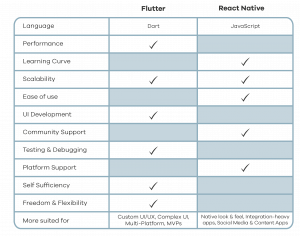
Flutter vs React Native: which is best?
They’re two prime contenders for the title of best mobile development platform.
But which is best for each case? Check who wins the Flutter vs React Native battle.
Flutter and React Native are two leading open-source frameworks for mobile app development. Each has a unique set of advantages and a few limitations. Flutter comes packed with a UI toolkit that powers customised apps with a unified look across devices. React apps, on the other hand, have a more native look and feel on each platform and rely on native components, ensuring a more platform-specific experience.
But which is best? In this side-by-side comparison of Flutter vs React Native, we’ll explore the similarities and differences of both frameworks, and hopefully by the end of it, you’ll be able to make an informed decision for your next mobile app project. And if you enjoy side-by-sides, be sure to check out our other two side-by-side comparisons: React vs Angular and Vue vs React!
What is Flutter?
Flutter is a development framework with an extensive set of tools, libraries, and widgets. It is used mainly for mobile development, but its capabilities extend to web and desktop applications. Flutter was developed by Google in 2017, and it now one of the most popular cross-platform development framework.
What is React Native?
React Native was developed by Facebook in 2015 and is also a cross-platform mobile development framework. React Native relies on JavaScript, one of the most popular programming languages, to create native apps for iOS and Android.
And now, on to the comparison.
Flutter vs React Native: side by side comparison
Programming Language winner: depends!
Flutter uses Dart, a language with C-style syntax, developed by Google in 2011. Dart compiles to machine code, JavaScript, or WebAssembly. React Native uses JavaScript and JSX (JavaScript XML, an extension of JavaScript that allows you to write HTML in React). DEpending on which programming language your team is more comfortable with, you may want to choose one framework or the other.
Performance winner: React Native
Prior to 2022, React Native relied on a bridge to allow JavaScript to communicate with native modules. This was a drawback in terms of performance, as it could lead to some overhead (essentially more resources and computation time), latency, and others. In 2022, a new layer was introduced to React Native, JSI (JavaScript Interface) which is now the middleman between JavaScript and native elements. This change improved performance in React Native. Flutter, on the other hand, compiles to native machine code, and although the gap in performance in Flutter vs React Native is very narrow, Flutter apps are still slightly faster than React Native apps.
Learning Curve winner: React Native
React Native is easy to get started with, and even more with prior knowledge of JavaScript. Flutter uses Dart, which is a whole other language. So, the learning curve is definitely steeper for Flutter.
Scalability winner: it’s a tie!
Tough one. Both Flutter and React Native are very scalable, and it is difficult to point one of them as better than the other. Plus, it’s not only in their hands; scalability depends greatly on the design and architecture of an app, API backend, as well as the overall backend system. It is possible to ruin an apps scalability with a monolithic architecture – try event-driven architecture instead! – inefficient database queries, and so on, and those don’t depend on mobile frameworks exactly. So, to settle the question of Flutter vs React Native scalability, we’ll consider it a tie.
Ease of Use winner: React Native
React Native is much easier and faster to install and start using than Flutter. On the other hand, Flutter has a comprehensive, pre-built and proprietary widgets, while React Native relies on third-party libraries. Flutter’s widgets aren’t adaptive, and need to be configured manually, while React Native is pretty much self-adaptive – that is, using Flutter, developers need to make platform-specific configurations manually, and they don’t with React Native. For that reason, and because the learning curve is steeper in Flutter, even with its easy installation, React Native is easier to use than Flutter.
UI Development winner: Flutter
Flutter has a very rich set of customisable widgets and offers a high degree of control over the UI. In fact, Flutter’s UI Design is very consistent across platforms, allowing for a unified look and feel of one app on both Android and iOS. It also compiles to native code, which can contribute to a more polished UI due to smooth animations, for example. In terms of UI Development, React Native allows more customisation but relies more on native components for complex UI elements. While both can create excellent UIs, we choose Flutter for UI Development.
Community Support winner: React Native
React Native absolutely takes the prize here. More mature and JavaScript-based, React Native has a large and well-established community, with vast libraries and third-party packages, and plenty of documentation. Now, Flutter has a growing community although way smaller than React Native’s. It also has an impeccably organised and structured documentation compared to React Native which, being reliant on third-party libraries, has poorly maintained documentation. The winner is clear: React Native has larger community and support.
Testing and Debugging winner: Flutter
Flutter offers a comprehensive development environment called Flutter DevTools with specific tools for testing, debugging, profiling, and monitoring. React Native uses the standard debugging tools for JavaScript like Jest, ChromeDevTools and a wide range of third-party libraries. Because of this, Flutter’s test & debug integrated tools are more appreciated.
Platform Support winner: Flutter
React Native primarily supports iOS and Android, but can be extended to other platforms using third-party libraries – such as Expo, that extends React Native to support web and PWA development besides traditional mobile app development. Flutter, however, supports iOS, Android, web, and desktop (Windows, macOS, and Linux). Therefore, Flutter has better platform support than React Native.
App Type winner: depends!
Flutter and React Native are excellent frameworks. However, they are each more suited for different types of apps. Flutter might do better for apps with custom UI/UX such as e-commerce, media streaming, and apps that demand unique designs; it also works well for 2D games, startup prototypes and multi-platform apps. React Native may be best for apps that require consistent native UX, content display-focused apps like news readers, blogs, and informational content, and even social media and apps that rely on real-time data updates.
Flutter vs React Native: the verdict
Let’s see which of these cross-platform mobile development framework is best for your project:

So, what is the winner of this Flutter vs React Native contest for you? As always, it’s impossible to declare an absolute winner without the proper context of the project at hand, dev team expertise, timeline, third-party integration needs and such.
Still on the fence about Flutter vs React Native?
At Near Partner, we can help you understand what framework is best for your business, and work with you and your team to achieve the perfect solution that satisfies your business’ needs. We have an amazing team to guide you. See which of our Nearshore Solutions is the best fit for your company, or just drop us a line if you are want to brainstorm some. Get in touch with Near Partner and make your mobile app project a reality!




